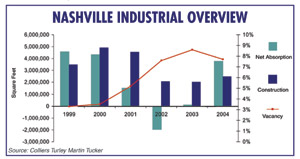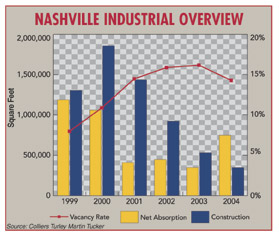|
FEATURE ARTICLE, DECEMBER 2004
2005 Outlook
NASHVILLE, TENNESSEE
Industrial Market
The economy is improving and national and regional economic
indicators continue to point to an expansion. Corporations
have increased productivity and cut costs by eliminating excess
capacity during the recent economic downturn, and they are
finally into an expansionary mode. Interest continues in single-tenant
facilities in the 22,000- to 30,000-square-foot range, and
build-to-suit facilities will still be needed to meet market-specific
needs. We look for sustained periods of growth and project
absorption in the 2.5 million-square-foot range for 2005.


Multifamily Market
In response to an improving economy and apartment market coupled
with low interest rates, Nashville is witnessing a significant
increase in apartment construction. There are currently more
than 3,000 units under construction as compared to less than
500 units completed in 2003. Murfreesboro leads the pack with
almost 1,400 units currently under construction.
Not unlike many other cities, Nashville is experiencing a
downtown revitalization and a return to urban living. Currently
there are approximately 1,500 units downtown, but there are
more than 700 more units either under construction or planned,
most of which are for-sale product.
Retail Market
The Nashville MSA will continue its retail growth in the outlying
submarkets of Murfreesboro/Rutherford County, Hendersonville/Gallatin,
Cool Springs and Mt. Juliet/Wilson County. The immediate Nashville
area’s most desired locations are constrained for expansion
by lack of available land, and growth in these areas will
be dependent upon developers choosing to level older centers
and start fresh. Such is the case in Green Hills with H.G.
Hill Company demolishing its former location and additional
shop space to construct a new 162,000-square-foot mixed-use
venue. Shopping centers remain the choice product for the
investment market.
Investment
The recovery in the corporate economy and the increasing likelihood
of higher interest rates should help close the gap between
the real estate capital markets and physical space market
fundamentals. Vacancy rates should fall as tenant demand recovers
and new supply remains modest, while rising interest rates
and an improving outlook for other asset classes diminish
the appeal of real estate yields. For investors, events signal
a shift in investment strategy from the credit-driven investing
that has dominated the market in recent years to strategies
that focus on the opportunities created by the recovery in
demand and, eventually, rents.
Office Market
Look for steady, albeit incremental, growth in 2005. Expectations
for the office market include a reduction in the market-wide
vacancy rate to 13.5 percent and net positive absorption of
approximately 1 million square feet. Sublease space will remain
steady in the slower growth submarkets, but will not be an
impediment to speculative construction. New multi-tenant facility
construction, a topic of conversation, speculation and contention
for the CBD, will come to fruition. However, the most likely
areas for speculative construction remain the Brentwood/Cool
Springs area.
— Whitfield Hamilton, managing principal, Colliers
Turley Martin Tucker, Nashville Regional Office
| In 2005 we will see an increase in rental
rates and less concessions for tenants, which is caused
by the lower vacancy rates in the suburban markets. Continued
job growth, which will in turn create expansion among
existing businesses, will help span new business and help
absorb some of the shadow space still on the market.
Leasing has improved previously from the past 2 years.
While absorption numbers are on track with previous averages,
they have been boosted by approximately four large users
in the Airport North, Brentwood and MetroCenter submarkets.
As of third quarter 2004, office absorption is 450,453
square feet.
The vacancy declined in Brentwood, Cool Springs and MetroCenter
throughout 2004. Brentwood and Cool Springs will continue
this throughout 2005 due to the quality of developments
and workplace environments and price of competitive lease
rates in these two areas. With the lack of space in the
Brentwood and Cool Springs areas, new development should
start by the end of 2005.
The recent completion of the Roundabout Plaza has relocated
several large tenants away from the CBD. The Summit on
West End, which will be a multi-use building of approximately
900,000 square feet, will have an impact on the market
as well. Two new proposed skyscrapers in the CBD could
negatively affect the strength of the downtown market:
the SunTrust Tower (350,000 square feet of Class A office
space) and the Signature Tower (325,000 square feet of
Class A office space).
— Grubb & Ellis|Centennial
|
©2004 France Publications, Inc. Duplication
or reproduction of this article not permitted without authorization
from France Publications, Inc. For information on reprints
of this article contact Barbara
Sherer at (630) 554-6054.
|
